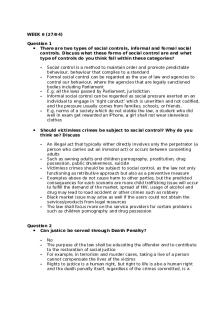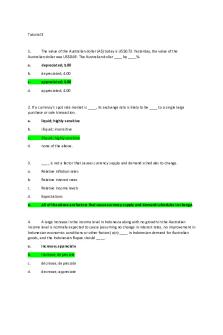Tutorial 3 - EOS, VLE PDF

| Title | Tutorial 3 - EOS, VLE |
|---|---|
| Author | Thao Le |
| Course | Material And Energy Balances |
| Institution | Monash University |
| Pages | 2 |
| File Size | 130.7 KB |
| File Type | |
| Total Downloads | 109 |
| Total Views | 151 |
Summary
Tutorial 3...
Description
CHE2166 Introduction to Process Simulation Tutorial 3: Equations of State Equations of State: 1.
Using Excel, find the molar volume of ammonia gas at 400°C and a range of pressures from 0.1 to 100 atm, using the following – (a) Ideal gas law (b) Redlich-Kwong-Soave equation of state Plot the molar volume against pressure for both the cases above on the same graph. At which pressure does the gas start behaving as a non-ideal gas?
2.
Consider the following mixture that is coming out of a methanol reactor. CO, 100; H 2, 200; methanol, 100 kmol/h. The gas is at 100 atm and 300°C. Compute the specific volume of the mixture in Excel and Aspen Plus using (a) ideal gas law (b) Redlich–Kwong equation of state (c) Redlich–Kwong–Soave equation of state. Give reasons why the ideal gas or Redlich–Kwong equations of state are not expected to be valid choices. The acentric factors for the RK–Soave method are: CO, 0.049; H2, −0.22; methanol, 0.559. How do the three answers compare? Is the gas ideal or not? Comment.
3.
The stream in Table 1 comes out of a distillation tower. It is at 138 psia and 197.5°F. If the pressure is reduced (adiabatically) to 51 psia, what will be the vapour fraction and temperature? (Hint: in Aspen Plus, put a valve before the Flash2 unit, and reduce the pressure with the valve block.) For hydrocarbons at these conditions Aspen suggests using Peng–Robinson, LK–PLOCK, or SRK. Use SRK. Table 1: Input stream for Q3
4.
The flow rates out of an equilibrium reactor to make hydrogen were CO: 5.25, hydrogen: 1095, carbon dioxide: 699, and water: 364.2 (use these as lb mol/h). Ideally, you could cool the stream and remove all the water. In actuality, you might not be able to condense all the water, and the water may contain trace amounts of the other components. This problem challenges you to find out how much. The outlet from the reactor is at 450 K, 1 atm, and is cooled to 80°F, still at 1 atm.
Prepared by Dr. A. Tanksale and Dr. P.E. Poh
(a) What are the K-values for the three species at these conditions? A flash separation (Flash2 in Aspen) is adequate to model the condenser. Using the mole fractions yi and xi obtained by Aspen Plus for the vapour and liquid respectively, calculate the K-values, Ki = yi/xi. (b) Do the simulation for an ideal solution and also for another choice of thermodynamic model. Aspen suggests that for chemicals use NRTL, Wilson, UNIQUAC, or UNIFAC. Use NRTL here. (c) Your report should have a flowsheet and give the mass balances. Discuss the difference between the two cases and why you think one might be better. How can you find out which is more realistic? 5. Model the vapour–liquid equilibria data (Table 2) of ethyl alcohol (1) and ethyl acetate at 1 atm using the UNIQUAC model in Aspen Plus. Also compare with experimental data obtained using the NIST TDE system (Murti and Van Winkle, 1959). Table 2: Vapour-Liquid Equilibrium Data for Ethyl Alcohol (1) and Ethyl Acetate system
Prepared by Dr. A. Tanksale and Dr. P.E. Poh...
Similar Free PDFs

Tutorial 3 - EOS, VLE
- 2 Pages

Fn2191 VLE - Study guide
- 136 Pages

Cumulative notes EOS 202
- 10 Pages

Eos 20d digital manual
- 85 Pages

Freehold covenants case material VLE
- 28 Pages

Exp 6-VLE Results, Discussion
- 8 Pages

Tutorial 3
- 3 Pages

Tutorial 3
- 4 Pages

Tutorial 3
- 4 Pages

Tutorial 3
- 12 Pages

3 - tutorial
- 6 Pages

Tutorial 3
- 6 Pages

Tutorial 3
- 4 Pages

6.0.Cliente Charles - EOS I
- 1 Pages

Tutorial 3 - Lecture notes 3
- 5 Pages

Tutorial 3 Answers
- 4 Pages
Popular Institutions
- Tinajero National High School - Annex
- Politeknik Caltex Riau
- Yokohama City University
- SGT University
- University of Al-Qadisiyah
- Divine Word College of Vigan
- Techniek College Rotterdam
- Universidade de Santiago
- Universiti Teknologi MARA Cawangan Johor Kampus Pasir Gudang
- Poltekkes Kemenkes Yogyakarta
- Baguio City National High School
- Colegio san marcos
- preparatoria uno
- Centro de Bachillerato Tecnológico Industrial y de Servicios No. 107
- Dalian Maritime University
- Quang Trung Secondary School
- Colegio Tecnológico en Informática
- Corporación Regional de Educación Superior
- Grupo CEDVA
- Dar Al Uloom University
- Centro de Estudios Preuniversitarios de la Universidad Nacional de Ingeniería
- 上智大学
- Aakash International School, Nuna Majara
- San Felipe Neri Catholic School
- Kang Chiao International School - New Taipei City
- Misamis Occidental National High School
- Institución Educativa Escuela Normal Juan Ladrilleros
- Kolehiyo ng Pantukan
- Batanes State College
- Instituto Continental
- Sekolah Menengah Kejuruan Kesehatan Kaltara (Tarakan)
- Colegio de La Inmaculada Concepcion - Cebu